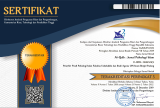The Personality of the Hadith Scholar and Its Importance to Psychology
Abstract
Keywords
Full Text:
PDFReferences
Aliyeva, N. (2020). The Sultan of Hadith Scientists - Imam Al-Bukhari. JournalNX A Multidisciplinary Peer Reviewed Journal , 6 (10), 281-284.
Allik, J. (2005). Personality dimensions across cultures. Journal of Personality Disorders , 19, 212-232.
Al-Mubarakfuri, A. S. (2016). Sirah Kehidupan Imam Bukhari Penghulu Para Fuqaha dan Imamul Muhaddisin. (A. S. Rahman, Trans.) Sungai Buloh: Kemilau Publika Sdn Bhd.
Azmi, A. S., Nor, Z. M., & Nasir, M. N. (2013). Kekeliruan dan Kritikan Terhadap Imam Al-Bukhari: Satu Tinjauan Awal. Jurnal Hadis , 2 (1), 9-29.
Baharom, N. (Ed.). (2014). Kamus Dewan (4 ed.). Kuala Lumpur: Dewan Bahasa dan Pustaka.
Bhoite, S. D., & Shinde, L. S. (2019). An Overview of Personality Development. International Journal of Trend in Scientific Research and Develpment , Special Issue, 138-141.
Bhullar, N., Well, H., & Schutte, N. S. (2020). Personality and Positive Psychology. In The Wiley Encyclopedia of Personality and Individual Differences: Model and Theories (Vol. IV, pp. 423-427). New York: John Wiley & Sons Ltd.
Brown, R., Franz, D., Ibarra, B., & Sullivan, M. (2014). Personality: A Six-Day Unit Lesson Plan for High School Psychology Teachers. Washington: American Psychological Association.
Carina, T., & Supriyadi. (2016). Studi Korelasi Perilaku Adaptif dan Kecerdasan Emosional dengan Prestasi Belajar pada Siswa Under Achiever di Bali. Jurnal Psikologi Udayana , 3 (1), 35-44.
Cattell, H. E., & Mead, A. D. (2008). The sixteen personality factor questionnaire (16PF). In G. J. Boyle, G. Matthews, & D. H. Saklofske (Eds.), The SAGE handbook of personality theory and assessment: Vol 2. Personality measurement and testing (pp. 135-159). Thousand Oaks, CA: Sage.
Cuyper, N. D., Heijden, B. I., & Witte, H. D. (2011). Associations between Perceived Employability, Employee Well-Being, and Its Contribution to Organizational Success: A Matter Of Psychological Contracts? The International Journal of Human Resource Management , 22 (7), 1486-1503.
Geukes, K., Zalk, M. V., & Back, M. D. (2017). Understanding Personality Development; An Integrative State Process Model. International Journal of Behavioral Development , 42 (1), 43-51.
Goh, E. L., & Lee, M. C. (2016). Person-Job Fit, personality, organizational commitment and intention to stay among employees in marketing departments. Jurnal Psikologi Malaysia , 30 (1), 80-89.
Griffin, B., & Hesketh, B. (2005). Are conscientious workers adaptable?. Australian Journal of Management , 30 (2), 245-259.
Halim, F. w., & Nawawi, R. (2013). Pengaruh Personaliti dan KompetensiTerhadap Prestasi Kerja Adaptif Pegawai Psikologi Perkhidmatan Awam. Jurnal Psikologi & Kaunseling Perkhidmatan Awam Malaysia , 8, 53-69.
Huang, J. L., Ryan, A. M., Zabel, K. L., & Palmer, A. (2014). Personality and adaptive performance at work: A meta-analytic investigation. Journal of Applied Psychology , 99 (1), 162-179.
Ismail, Y. (2016). Biografi Imam Bukhari (810-870 M) Pelajaran Hidup Sang Penjaga Hadith Nabi (Vol. 1). (A. Maftuhin, Trans.) Depok: Keira Publishing.
Jamrah, A. M. (2014). Ringkasan Sahih Al-Bukhari. (M. F. Kamaludin, Trans.) Ampang: Sofa Production Sdn Bhd.
Kitab Sahih Al-Bukhari. (2018, March 27). Portal myHadith , p. Rujukan.
Mount, M. K., & Barrick, M. R. (1995). The Big Five personality dimensions: Implications for research and practice in human resources management. Research in Personnel and Human Resources Management , 13, 153-200.
Nawi, N. H., & Othman, B. (2016). Personaliti - Konsep, Kunci dan Sumber Menurut Perspektif Islam. UMRAN – International Journal of Islamic and Civilizational Studies , 15-24.
Park, L., & Guay, R. P. (2009). Personality, Values & Motivation. Personality and Individual Differences , 47, 675-684.
Parks-Leduc, L., Feldman, G., & Bardi, A. (2015). Personality Traits & Personal Values: A Meta-Analysis. Personality and Social Psychology Review , 19 (1), 3-29.
Roberts, B. N., Caspi, A., & Moffitt, T. E. (2003). Work Experiences ad Personality Development in Young Adulthood. Journal of Personality and Social Psychology , 84 (3), 582-593.
Sari, M., & Asmendri. (2020). Penelitian Kepustakaan (Library Research) dalam Penelitian Pendidikan IPA. NATURAL SCIENCE: Jurnal Penelitian Bidang IPA , 6 (1), 41-53.
Schwartz, S. H. (1992). Universals in the content and structure of values: Theoritical advances and empirical tests in 20 countries. In M. P. Zanna, Advances in experimental social psychology (pp. 1-65). San Diego: Academic Press.
Sembilan, J. A. (2016). Keunggulan Imam Al-Bukhari. Seremban: Majlis Agama Islam Negeri Sembilan.
Seršić, D. M., & Tomas, J. (2014). The Role of Dispositional Employability in Determining Individual Differences In Career Success. Journal for General Social Issues , 4, 593-613.
Shah, F. A., Soroni, M. K., & Wazir, R. (2010). Manahij Al-Muhaddithin. Kuala Lumpur: Jabatan Al-Quran dan Hadith Akademi Pengajian Islam Universiti Malaya.
Soroni, M. K. (2021, March 07). Kitab Al-Bukhari paling sahih selepas al-Quran. Harian Metro , p. Addin.
Tahir, A. F., Aini, Z., & Rasit, R. M. (2018). Perubahan Personaliti Berdasarkan Faktor Agama Menurut Perspektif Islam. E-Journal of Islamic Thought and Understanding , 2 (1), 60-79.
Zahrah, M. A. (1976). Tarikh al-Madzahib al-Islamiyah: fi tarikh al-madzahib al-fiqhiyyah. Hejaz: Dar Al-Fikr Al-'Arabi.
Zin, R. A. (2005). Pengantar Ulum Hadis Teks Pengajian Islam (2 ed.). Kuala Lumpur: Pustaka Salam Sdn Bhd.
Refbacks
- There are currently no refbacks.
Ruang Jurnal,
Fakultas Ushuluddin dan Studi Agama,
UIN Imam Bonjol Padang
Jl. Mahmud Yunus No.6,Lubuk Lintah,
Kota Padang, Sumatra Barat
E-mail: jurnal-alqalb@uinib.ac.id

This work is licensed under a Creative Commons Attribution-ShareAlike 4.0 International License.



